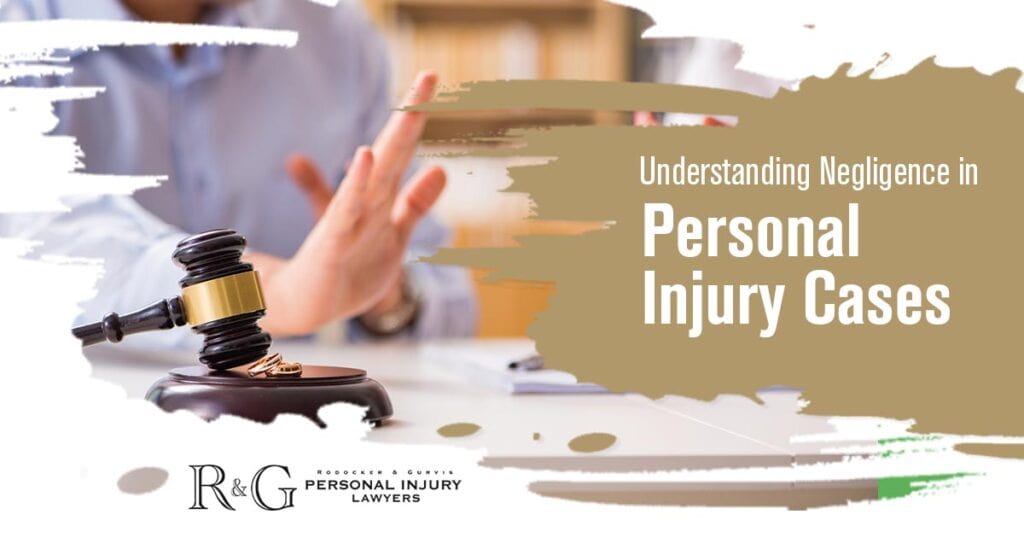Personal injury cases are often challenging and complex to navigate, especially when determining who is at fault for injuries. Negligence is the legal basis necessary for a personal injury claim, and understanding what it means is important.
Negligence is critical in determining if an injury victim can receive financial compensation and how much they might receive. In the United States, negligence laws can vary by state, with states typically adopting two systems for determining negligence.
- Contributory negligence completely bars the injured party from receiving compensation if they are in any way at fault, no matter how insignificant their contribution to the incident.
- Comparative negligence: allows the injured party to receive compensation even if they are partially at fault for the incident, but their percentage of fault will reduce the amount.
What is Negligence?
Negligence occurs when another person fails to utilize the degree of care that another sensible person would in similar conditions.
Some examples of negligence include:
- Dog owners failing to keep their dogs on a leash.
- Drunk driving
- A property owner’s failure to keep premises in good and safe condition
- Failure to secure a semi truck’s load properly
Suppose someone else’s actions or inactions are responsible for causing the accident leading to your injuries. In that case, you’ll need to prove the four elements of negligence to have a successful personal injury claim. These elements are:
- Duty of care
- Breach of duty
- Causation
- Damages
Duty of Care
Duty of care is the first element that needs to be proved in a personal injury claim. A duty of care requires one person to act with reasonable caution or care toward another person. To establish a duty of care, you must show evidence of a relationship between both parties. The relationship can be implied from surrounding circumstances, like driving on the road or walking into a business, or it may be explicit in an agreement or contract.
A duty of care can exist in many different types of situations. Some common examples of a duty of care include:
- Dog bite cases: Every dog owner owes the public a duty of care to control their dog and ensure it doesn’t pose a safety risk to others.
- Premises liability cases: Every business owner owes a duty of care to their customers or clients that their premises don’t have safety issues and are free from harmful defect
- Product liability cases: All manufacturers owe a duty to the buyers that their products are free from manufacturing and design defects.
- Traffic accident cases: Every driver on the road has a duty of care to obey traffic laws, drive safely, and obey them. Every driver owes this duty of care to all other drivers and pedestrians.
Breach of Duty
After proving that a party owed you a duty of care, you must prove they violated that duty of care.
A breach of duty can be proved by showing evidence the party didn’t act when they should have or acted wrongfully. For example, violations of the duty to drive safely include failure to stop at a stop sign, speeding, and driving while under the influence of drugs or alcohol.
Causation
The third element of negligence that must be proved is causation, which is the connection between your damages and the breach of duty. Causation can be complicated to prove, and many negligence claims fail because causation cannot be established.
A knowledgeable personal injury lawyer can prove causation using the following types of evidence:
- Accident reconstruction
- Black box data
- Expert testimony
- Medical reports
- Photographs
- Police reports
- Video surveillance
- Witness interviews
In addition to proving causation, you must demonstrate that the other party’s actions or inactions were the proximate cause of your injuries. Proximate cause is the direct cause-and-effect relationship between one party’s injuries and the other party’s actions or inactions.
Our attorneys at R & G Personal Injury Lawyers can help you collect evidence to support causation and prove proximate cause, which can be challenging, so that we can fight for the maximum financial compensation possible.
Damages
In personal injury cases, damages refer to the physical, emotional, and financial injuries caused by a negligent act. Damages can be economic, such as lost wages or medical bills, or noneconomic, such as mental trauma, emotional trauma, and pain and suffering. Proving damages in a personal injury claim is as crucial as proving duty, breach, and causation.
To prove damages, you must provide evidence that documents the injuries you sustained due to the other party’s negligence. Documentation often used to prove damages includes:
- Bank statements
- Bills
- Medical documents
- Pay stubs
- Tax documents
Depending on the nature of the injuries you suffered and how those injuries affect your employment, you may be able to receive compensation for the following:
- At-home care
- Counseling
- Diagnostic testing
- Doctor visits
- Emotional distress
- Hospital stays
- Loss of consortium
- Loss of earning capacity
- Loss of enjoyment of life
- Loss of income
- Pain and suffering
- Physical therapy
Common Examples of Negligence
- Car accidents: Drivers can cause car accidents by driving distracted, not paying attention to the road, failing to follow traffic laws, driving through a stop sign or red light, and not being cautious enough for road conditions.
- Slip and fall incidents: A slip and fall accident occurs when you visit someone else’s property, slip or trip on something, and get hurt. Property owners bear the onus of promptly addressing broken fixtures such as stairs, installing cautionary signage for inconspicuous hazards like step-downs or wet floors, swiftly attending to any spills or messes that may pose an accident risk, and maintaining their premises at a level of reasonable safety.
- Medical malpractice: If a healthcare provider fails to uphold an appropriate duty of care, they can commit medical negligence or malpractice. Medical practitioners are obligated to go beyond merely behaving as an average individual would in a comparable circumstance; they are expected to conduct themselves as reasonably cautious experts within their specific domain. Typically, an expert witness is needed to demonstrate whether a medical professional has fallen short of fulfilling this heightened standard of care.
- Product liability cases: Companies or manufacturers can negligently create defective products that hurt customers. The three ways this can occur are 1) design defects, which occur when a product has a faulty design that can pose a risk of injury; 2) manufacturing defects, which are mistakes that have been made during the manufacturing process and result in an unsafe product; and 3) warning failures, which don’t tell users about the dangers of the product.
Importance of Legal Representation
Legal representation is essential to pursue a personal injury lawsuit and hold a negligent party accountable for your injuries. There are critical deadlines for filing a lawsuit or taking your case to trial; you must complete all of these deadlines to avoid losing your chance to seek compensation.
Our firm’s skilled personal injury lawyer will ensure you meet any necessary deadlines and will fight to achieve justice and compensation for your injuries. An attorney specializing in personal injury will help gather compelling evidence and clear documentation proving you deserve financial compensation for your injuries.
Consult with R&G Personal Injury Attorneys About Your Personal Injury Claim
Personal injury cases can be confusing and complex. If you’ve experienced an accident or have been injured, it’s essential to contact an experienced personal injury attorney as soon as possible to ensure your rights are protected. An attorney can evaluate your case, advise you about your options, guide you through the process, and provide you have the best possible chance of receiving the financial compensation you deserve.
Call R&G Personal Injury Attorneys today in Columbus, Ohio, at 614-221-3750 or Cary, North Carolina, at 919-561-6800 for a free consultation.





